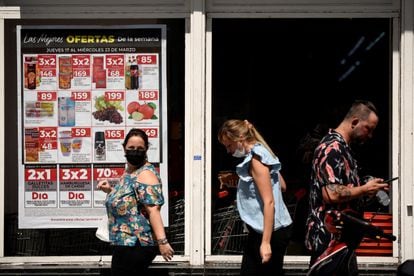In front of a supermarket with the prices of some products in the window, in Buenos Aires, on March 17, 2022. MARIANA NEDELCU (REUTERS)
Inflation in Argentina reached 60.7% year-on-year in May, the highest rise since 1992. Last month it closed with 5.1% inflation, somewhat better than the 6% registered in April and the 6.7 in March, but far from the figures that the South American country needs if it intends to meet the goals agreed with the IMF last year, below 50%.
Prices have risen 29.3% during the first five months of the year.
The latest survey of expectations that the Central Bank publishes each month already forecasts an inflation of 72.7% for 2022.
In the year, it reaches 29.3%.
Health and transportation services were the ones that increased the most in May, followed by food (4.4%).
Days before the data released by the Indec, the statistics office, the Minister of Economy, Martín Guzmán, had predicted a lower figure than in April.
"Of course any number of these that we're talking about are high," he said, "problematic for the functioning of our society and our economy."
Inflation is a chronic problem in Argentina.
The increase in prices has been in two annual digits since the exit of the convertibility of the peso with the dollar, in 2002. No government, either left or right, has found the formula to lower it.
At the heart of the matter is the fiscal deficit: Argentina spends more than it produces and covers that red either with external indebtedness -like the government of Mauricio Macri- or with monetary issue -as Kirchnerism has done historically.
Today, Argentina can do neither one thing nor the other: the interest rates it must pay keep it out of the international credit markets and the monetary issue is at its limit.
In 2021 alone, the Treasury transferred 2.1 trillion pesos to the national State, equivalent to 4.8% of GDP.
The situation is now aggravated by a particularly hostile international scenario for economies without credit and low levels of international reserves, such as Argentina's.
Inflationary pressure continues unabated in the United States, where the CPI recorded an interannual rate of 8.6% in May, a record since December 1981. The data makes it increasingly likely that the Fed will raise interest rates even more than expected. Was expected.
In March, the increase was 25 points and in May another 50 points.
The global uncertainty generates a migration of money towards safer investments and hits more unstable markets such as Argentina.
Last week, the debt bonds of the South American country collapsed and the country risk - the rate differential it pays on US debt - exceeded 2,000 points.
In September 2020, after agreeing with private creditors to restructure the debt, the Argentine country risk barely exceeded 1,000 points.
Subscribe here to the EL PAÍS América newsletter and receive all the key information on current affairs in the region.

